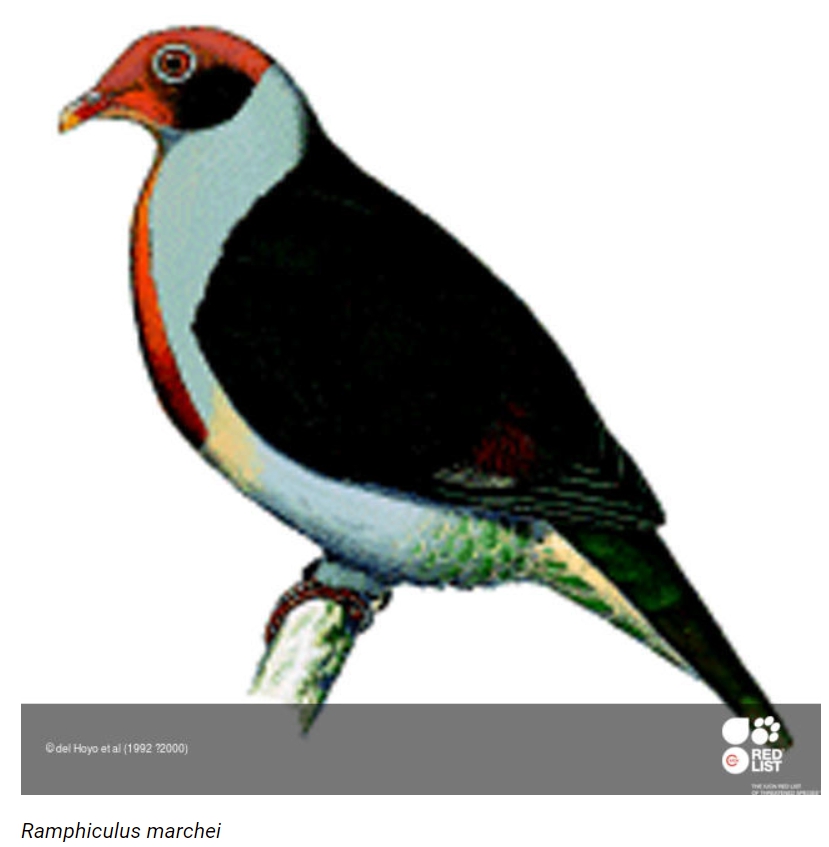| Citation |
BirdLife International. 2016. Ramphiculus marchei. The IUCN Red List of Threatened Species 2016: e.T22691317A93309047. https://dx.doi.org/10.2305/IUCN.UK.2016-3.RLTS.T22691317A93309047.en. Accessed on 03 May 2022. Brinkman, J.J., van der Ven, W., Allen, D., Hutchinson, R., Jensen, A.E., Perez, C. (2021): Checklist of birds of the Philippines. Wild Bird Club of the Philippines. www.birdwatch.ph |
Description |
JUSTIFICATION
This species qualifies as Vulnerable having undergone a rapid decline owing to forest loss, compounded by hunting and trade. It has now been reduced to a small, severely fragmented and declining population.
RANGE DESCRIPTION
Ramphiculus marchei is endemic to the island of Luzon in the Philippines, where it occurs chiefly in the northern provinces (Collar et al. 1999). It is known from at least 17 sites, with records from at least 11 since 1980. It was considered to be fairly common in the Abra highlands and on Mts Sicapo-o and Data during the 1940s and 1950s. However, it was uncommon or rare in the Sierra Madre mountains, except at Los Dos Cuernos, during surveys in the early 1990s. There are recent records from Balbalsang, Kalinga province (where apparently fairly common), Mt Data (where rare; possibly only two pairs), Mt Polis (presumably breeds) and Mt Amuyao (where heavily hunted) (D. Allen in litt. 2012). Familiarity with its call might reveal a greater abundance.
DESCRIPTION
The population size is preliminarily estimated to fall into the band 2,500-9,999 mature individuals. This equates to 3,750-14,999 individuals in total, rounded here to 3,500-15,000 individuals.
Trend Justification: Forest loss and fragmentation, compounded by hunting, are suspected to be driving a rapid decline in this speciess population.
HABITAT AND ECOLOGY
It is known from 450-1,500 m, with a lower limit in the Sierra Madre of 850 m, and one record from 2,300 m. It inhabits lowland and hill dipterocarp forest and mid-montane forest, with occasional records from stunted montane or mossy forest. It probably prefers primary forest above 1,000 m, is apparently unrecorded from secondary forest, and is seemingly unable to survive in selectively logged areas. It undertakes some seasonal movements, probably following fruiting trees.
THREATS
Forest loss, degradation and fragmentation are the chief threats, compounded by hunting for food and probably sport, and collection for trade (e.g. birds were being sold openly in several markets in 1994). Forest cover in the Sierra Madre has declined by 83% since the 1930s and most remaining areas are under logging concessions and may suffer further from major road-building plans. Little or no undegraded habitat remains at key sites such as Mts Data, Polis and Cetaceo, and quarrying and unregulated seasonal tourism threaten remaining forest on Mt Banahaw.
CONSERVATION ACTIONS
Conservation Actions Underway
It is known from two protected areas, Mt Pulog National Park (which lacks effective protection) and the Northern Sierra Madre Natural Park. There are also historical records from several areas now afforded national park status, including Maria Aurora Memorial National Park, Mt Bicol and Mt Banahaw/San Cristobal, although it is unclear what protection this classification confers. In the 1990s, the species featured on a bilingual environmental awareness poster in the "Only in the Philippines" series.
Conservation Actions Proposed
Conduct field surveys to identify and prioritise additional key sites supporting important populations. Intensively research its movements and basic ecological requirements to help clarify its conservation needs. Formally propose key sites (e.g. Mts Cetaceo and Polis) for protected status. Promote stricter enforcement of legislation designed to curtail hunting and trade. |

